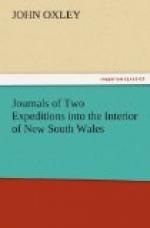May 6.—Proceeded down the river. It is impossible to fancy a worse country than the one we were now travelling over, intersected by swamps and small lagoons in every direction; the soil a poor clay, and covered with stunted useless timber. It was excessively fatiguing to the horses which travelled along the banks of the river, as the rubus and anthistiria were so thickly intermingled, that they could scarcely force a passage. After proceeding about eight miles, a bold rocky mount terminated on the river, and broke the sameness which had so long wearied us: we ascended this hill, which I named Mount Amyot, and from the summit had one of the most extensive views that can be imagined. On the opposite side of the river was another hill precisely similar to Mount Amyot, leaving a passage between them for the river, and the immense tract of level country to the eastward; this hill was named Mount Stuart. Vast plains clear of timber lay on the south side of the river, and which, from our having travelled on a level with them, it was impossible for us to distinguish before. These plains I named Hamilton’s Plains, and they were bounded by hills of considerable elevation to the southward; whilst the whole level country thus bounded was honoured with the designation of Princess Charlotte’s Crescent.
To the west of Mount Amyot the view was equally extensive, being bounded only by the horizon; some high detached hills, rising like islands from the ocean, broke, in some measure, the sameness of the prospect. I estimated that in the west north-west I could see at least forty miles, and in the south south-west as far; the view in other points being slightly interrupted by low ranges of hills, rising occasionally to points of considerable elevation: none of those elevated spots was nearer than twenty-five or thirty miles, and considerable spaces of clear ground could, by the assistance of the telescope, be distinguished, interspersed amidst the ocean of trees whence those hills arise: a long broken mountain, bearing W. 32 1/2. N., was named Mount Melville; one W. 24. N. Mount Cunningham; and another, bearing S. 70. W. Mount Maude. Smoke, arising from the fires of the wandering inhabitants of these desolate regions was seen in several quarters. At four o’clock we stopped for the evening, about three miles west of Mount Amyot.
I have reason to believe that the whole of the tract named Princess Charlotte’s Crescent is at times drowned by the overflowing of the river; the marks of flood were observed in every direction, and the waters in the marshes and lagoons were all traced as being derived from the river. During a course of upwards of seventy miles not a single running stream emptied itself into the river on either side; and I am forced to conclude that in common seasons this whole tract is extremely badly watered, and that it derives its principal if not only supply from the river within the bounding ranges Of Princess Charlotte’s




